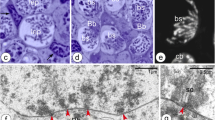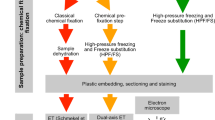Abstract
In this paper we describe meiotic prophase of female mice on successive days of embryonic and early postnatal development. For this purpose we used three different techniques on ovarian material, i.e., Giemsa staining for the light microscopic study of chromatin, silver staining for the light microscopic study of the synaptonemal complex (SC), and agar filtration followed by uranyl acetate staining for the electron microscopic study of the SC. — In all types of preparation it was impossible to distinguish leptotene stages, and we conclude that if leptotene really exists, it is of very short duration. — Two types of zygotene stages were found: the “normal” one, resembling zygotene stages in male mice, and a second type that has never been described in males and is characterized by, probably stable, unpaired regions together with totally unpaired axial elements of the SC. — The duration of pachytene was found to be 3–4 days, which is considerably shorter than in males. During early diplotene despiralization of the chromatin and disintegration of the axes of the SC were usually found together with desynapsis. — A considerable variation in distribution of meiotic stages was found between different litters in the same day of gestation. Fetuses in the same litter showed no significant variation. However, the oocytes in an ovary did not pass through meiosis synchronously, with differences up to several days. The appearance of chromosomes in a highly contracted state could not be interpreted as a preleptotene condensation stage but probably is a mitotic phenomenon.
Similar content being viewed by others
References
Bakken AH, McClanahan M (1978) Patterns of RNA synthesis in early meiotic prophase oocytes from fetal mouse ovaries. Chromosoma 67:21–40
Boer P de, Hoeven FA van der (1980) The use of translocation-derived “maker-bivalents” for studying the origin of meiotic instability in female mice. Cytogenet Cell Genet 26:49–58
Borum K (1961) Oogenesis in the mouse. A study of the meiotic prophase. Exp Cell Res 24:495–507
Crone M, Levy E, Peters H (1965) The durations of the premeiotic DNA synthesis in mouse oocytes. Exp Cell Res 39:678–688
Dietrich AJJ, Boer P de (1983) A sequential analysis of the development of the synaptonemal complex in spermatocytes of the mouse by electron microscopy using hydroxyurea and agarfiltration. Genetica 61:119–129
Dietrich AJJ, Mulder RJP (1981a) A light microscopic study of the development and behaviour of the synaptonemal complex in spermatocytes of the mouse. Chromosoma 83:409–418
Dietrich AJJ, Mulder RJP (1981b) The staining of the synaptonemal complex for light microscopic study in the mouse. Stain Techn 56:163–167
Evans CW, Robb DI, Tuckett F, Challoner S (1982) Regulation of meiosis in the foetal mouse gonad. J Embryol Exp Morphol 68:59–67
Hartung M, Stahl A (1977) Preleptotene chromosome condensation in mouse oogenesis. Cytogenet Cell Genet 18:309–319
Henderson SA, Edwards RG (1968) Chiasma frequency and maternal age in mammals. Nature 218:22–28
Jagiello G, Fang JS (1979) Analysis of diplotene chiasma frequencies in mouse oocytes and spermatocytes in relation to ageing and sexual dimorphism. Cytogenet Cell Genet 23:53–60
Kuhlman W (1970) Cytology and timing of meiotic stages in female germ cells of mammals and man. In: F Vogel, G Röhrborn (eds) Chemical mutagenesis in mammals and man. Springer Berlin, pp 180–193
Kurilo LF (1981) Oogenesis in antenatal development in man. Hum Genet 57:86–92
Lemon JG, Morton WRM (1968) Oogenesis in the golden hamster (Mesocricetus auratus). A study of the first meiotic prophase. Cytogenetics 7:376–389
Luciani JM, Devictor-Vuillet M, Gagné R, Stahl A (1974) An air-drying method for first meiotic prophase preparations from mammalian ovaries. J Reprod Fert 36:409–411
Moses MJ (1977a) Synaptonemal complex karyotyping in spermatocytes of the Chinese hamster (Cricetulus griseus). I. Morphology of the autosomal complement in spread preparations. Chromosoma 60:99–125
Moses MJ (1977b) Synaptonemal complex karyotyping in spermatocytes of the Chinese hamster (Cricetulus griseus). II. Morphology of the XY-pair in spread preparations. Chromosoma 60:127–137
Ohno S, Klinger HP, Atkin NB (1962) Human oögenesis. Cytogenetics 1:42–51
Ohno S, Smith JB (1964) Role of fetal follicular cells in meiosis of mammalian oöcytes. Cytogenetics 3:324–333
Oud JL, Reutlinger AHH (1981) Chromosome behaviour during early meiotic prophase of mouse primary spermatocytes. Chromosoma 83:395–407
Oud JL, Jong JH de, Rooij DG de (1979) A sequential analysis of meiosis in the male mouse using a restricted spermatocyte population obtained by a hydroxyurea/triaziquone treatment. Chromosoma 71:237–248
Peters H, Levy E, Crone M (1965) Oogenesis in rabbits. J Exp Zool 158:169–180
Polani PE, Jagiello GM (1976) Chiasmata, meiotic univalents, and age in relation to aneuploid imbalance in mice. Cytogenet Cell Genet 16:505–529
Rodman TC (1971) Chromosomes of the first polar body in mammalian meiosis. Exp Cell Res 68:205–210
Sheridan WF, Barrnett RJ (1969) Cytochemical studies on chromosome ultrastructure. J Ultrastr Res 27:216–229
Speed RM (1982) Meiosis in foetal mouse ovary. I. An analysis at the light microscope level using surface-spreading. Chromosoma 85:427–437
Stahl A, Luciani JM (1972) Nucleoli and chromosomes: Their relationships during the meiotic prophase of the human fetal oocyte. Humangenetik 14:269–284
Uchida IA, Lee VCP (1974) Radiation-induced nondisjunction in mouse oocytes. Nature 250:601–602
Uebele-Kallhardt B, Knörr K (1971) Meiotische Chromosomen der Frau. Humangenetik 12:182–187
Winiwarter H von (1901) Recherches sur l'ovogenèse et l'organogenèse de l'ovaire des mammifères (lapin et homme). Arch Biol 17:33–200
Woldringh CL, Jong MA de, Berg W van den, Koppes L (1977) Morphological analysis of the division cycle of two Escherichia coli substrains during slow growth. J Bacteriol 131:270–279
Yuncken C (1968) Meiosis in the human female. Cytogenetics 7:234–238
Author information
Authors and Affiliations
Rights and permissions
About this article
Cite this article
Dietrich, A.J.J., Mulder, R.J.P. A light- and electron microscopic analysis of meiotic prophase in female mice. Chromosoma 88, 377–385 (1983). https://doi.org/10.1007/BF00285860
Received:
Revised:
Issue Date:
DOI: https://doi.org/10.1007/BF00285860




